Discover the hassle-free joy of growing hydroponic tomatoes—these soil-free wonders eliminate pesky weeds and pests, making them the perfect choice for any green thumb!
The method provides direct delivery of water and nutrients to the plant roots, leading to optimal growth.
This system can be set up both indoors and outdoors, unaffected by weather conditions.
Hydroponic tomatoes are recommended for those interested in starting their own hydroponic garden.
Get ready to level up your gardening game by growing your very own hydroponic tomatoes!
We’ll explore the fascinating techniques behind hydroponics and show you how to get started on growing a juicy tomato in your very own hydroponic garden.
- Related article: Best Indoor Hydroponic Plants
Let’s get our green thumbs ready!
Why Grow Hydroponic Tomatoes?
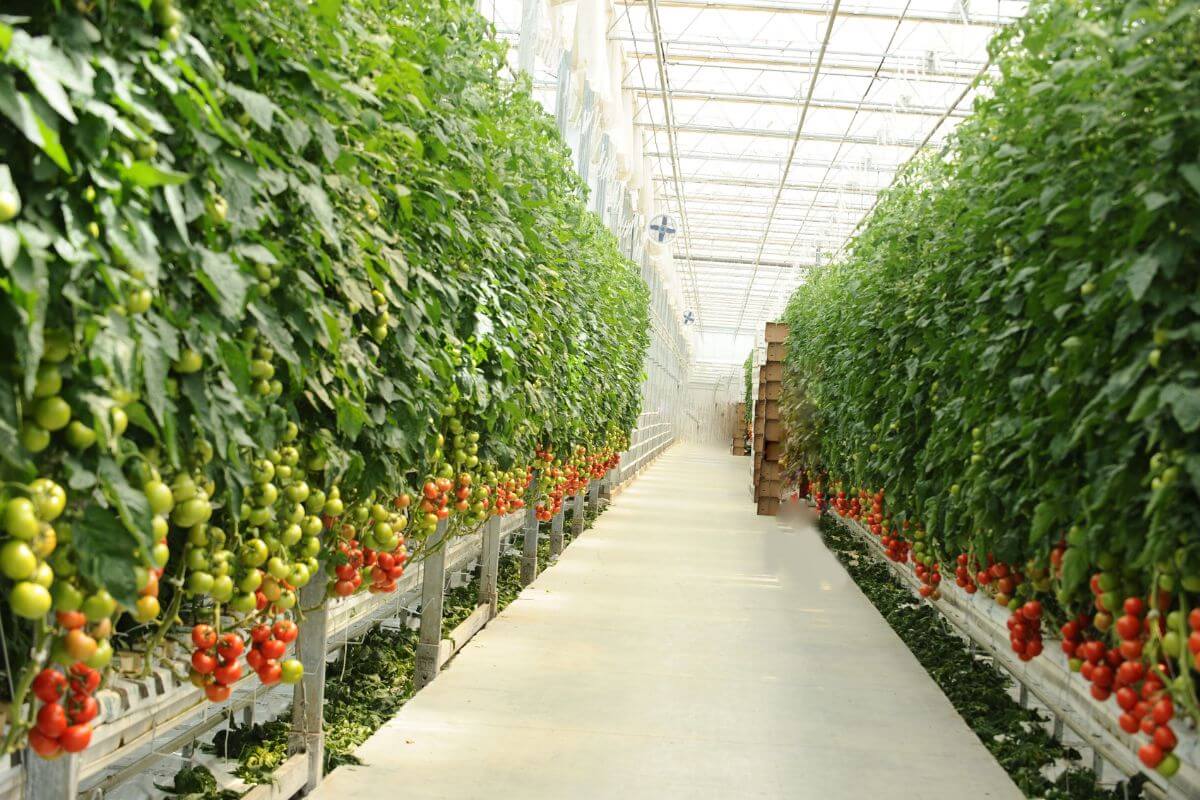
Benefits of Growing Hydroponic Tomatoes
- Hydroponic tomato growing can enhance yield by providing nutrients and water directly to the plant’s roots, resulting in optimal growth conditions.
- Hydroponic tomatoes can be grown without soil, making it possible to cultivate them in smaller spaces.
- Hydroponic tomatoes are grown indoors, away from potential pests.
- Growing in hydroponics reduces the number of soil-rooted diseases that will affect your tomatoes.
- Hydroponics requires less water usage than soil-based gardening.
- Delicious tomatoes which are larger in size.
- You can grow tomatoes all year round—there’s no season with hydroponics!
Drawbacks of Growing Hydroponic Tomatoes
- Understanding the correct amounts of nutrients needed for your plants can take some time to master.
- Growing hydroponic tomatoes can be expensive due to the equipment needed.
- Fungus grows easily in a hydroponic system.
- Hydroponics may avoid soil disease but it doesn’t avoid waterborne diseases that can destroy your crops.
- Hydroponic nutrients can be relatively expensive compared to normal fertilizers.
- Expect to pay more for your electric bills and other utility dues every month.
- Hydroponics requires commitment and countless hours doing maintenance.
Equipment Needed to Grow Hydroponic Tomatoes
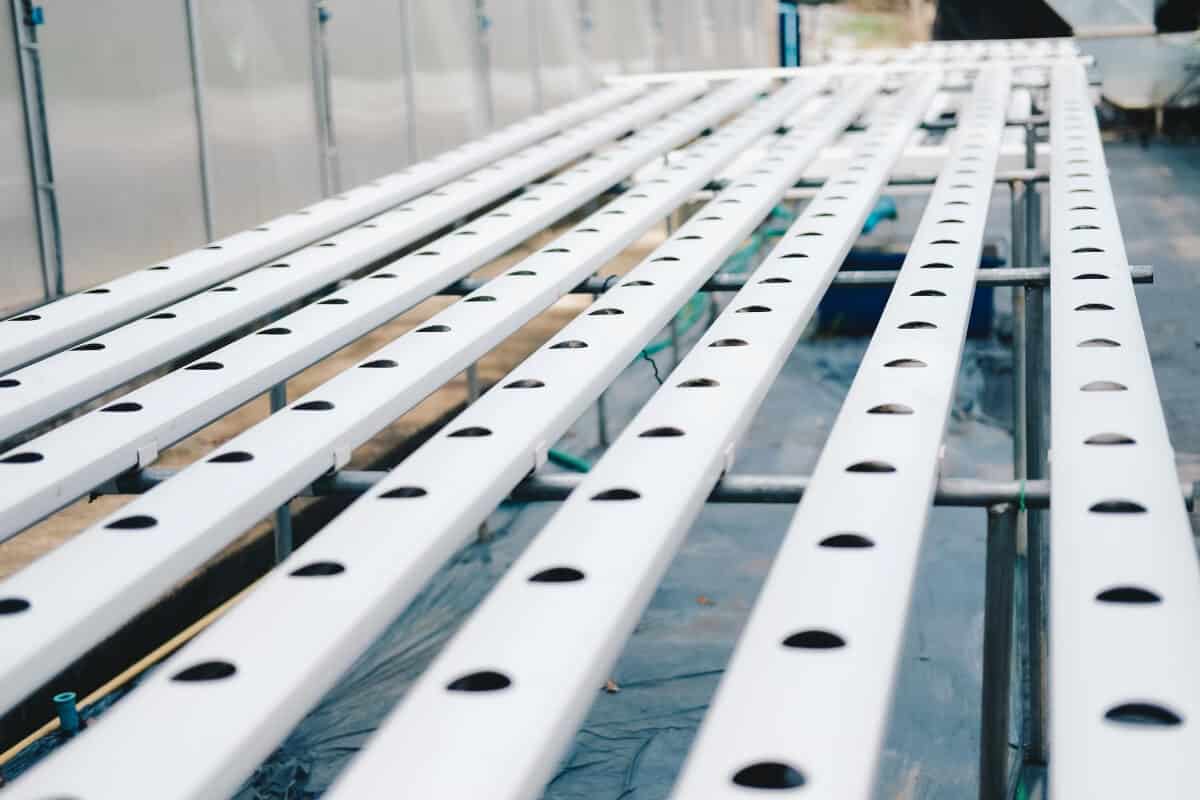
Growing hydroponic tomatoes will require some basic equipment in order to replicate the natural conditions that plants are accustomed to growing in.
The equipment required for hydroponics can become costly for first-time growers.
To grow hydroponic tomatoes, the basic equipment, and their uses, needed are:
- Air pump – A tool designed to inject oxygen into a water reservoir.
- Air stone – Air stone is a porous stone that attaches to the air pump and breaks up the air bubbles, increasing oxygenation in the water.
- Filter – A filter is a device used to remove debris, particles, and impurities from the water.
- LED lights/T5 grow light – Artificial lighting is used to provide plants with the necessary light for growth, which are adjustable to provide the specific spectrum and intensity of light required for optimal plant growth.
- pH testers – pH testers are devices used to measure the acidity or alkalinity of a solution, such as the nutrient solution in a hydroponic system.
- EC meter – Also known as conductivity meters, EC meter measures the electrical conductivity of a solution.
- Fan – The purpose of a fan in hydroponic planting is to provide proper ventilation and air circulation for the plants.
- Net pods – A common component of hydroponic systems, utilized to securely hold plants and their roots in place while enabling appropriate water and nutrient circulation.
- Water piping – The system of pipes and tubing that are utilized to transport water throughout a hydroponic setup.
- Irrigation equipment – Tools or devices that are utilized to deliver water to plants in a regulated manner.
- Heater – Used in hydroponic growing to ensure that the plants have a steady and ideal temperature for growth, depending on the environment.
- Grow tray – A grow tray is a container used to hold the plants, their growing medium, and their water or nutrient solution.
- Timer – A timer is crucial in hydroponic growing because it controls the timing and duration of the lighting and nutrient solution cycles for your plants.
- Plant containers – Utilized in hydroponic growing to secure the plants and their roots, while also enabling nutrient-rich water to circulate through them.
- Water reservoir – A critical component of the container system. It stores the nutrient solution that provides nourishment to the plants and ensures they remain hydrated.
- Pruning scissors – A type of gardening tool used for cutting and trimming plants, particularly for removing dead or unwanted parts of a plant.
How to Grow Hydroponic Tomatoes
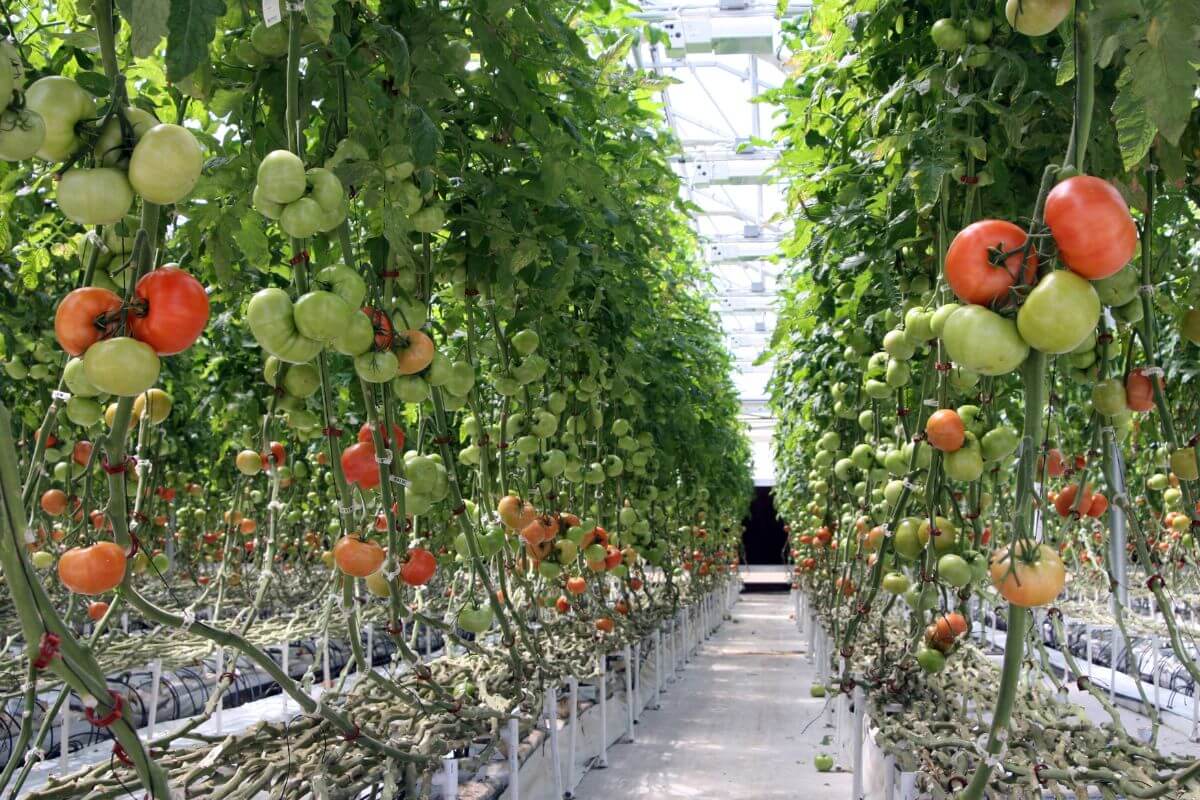
Choose the Variety of Tomato to Grow
Hydroponics is a versatile method of growing plants, as many can thrive using this technique. Notably, tomatoes have shown exceptional results in hydroponic gardening.
Hydroponic farming can yield a variety of tomato types, with varying growth rates.
Being aware of the distinction between indeterminate and determinate tomatoes can be beneficial.
Indeterminate and determinate tomatoes differ in their growth patterns and fruit production. Indeterminate tomatoes can grow indefinitely and produce fruit throughout the growing season, while determinate tomatoes have a predetermined size and produce fruit for a short period.
Indeterminate tomato varieties are suitable for commercial growers and those seeking a consistent yield, whereas determinate varieties are beneficial for gardeners desiring a single harvest.
Indeed, the beauty of having different varieties in a plant species is diversity.
Feast your eyes on some of the most commonly cultivated varieties of tomatoes in hydroponics:
- Beefsteak Tomatoes – A type of tomato known for their large size and mild flavor. They typically have a round or oval shape and can weigh up to one pound.
- Tomatoes-on-a-vine – Refer to groups of tomatoes growing on a singular stem, typically including two to four tomatoes. They are generally sizable, succulent, and possess a sweet taste.
- Cherry Tomatoes – Small, round tomatoes that typically resemble the size of a marble or grape. The taste of this variety is a combination of sweet and tangy, and they come in different colors such as red, yellow, orange, and black.
- Cocktail Tomatoes – A tomato variety that falls in size between cherry tomatoes and regular-sized tomatoes. The typical shape of this variety is round or oval, and their flavor is usually mild.
- Grape Tomatoes – Small and round, with a size similar to grapes. This variety possesses a slightly acidic yet sweet flavor and comes in a range of colors, including red, yellow, orange, and black.
Choose the Hydroponic Technique
Choosing the right technique to hydroponically grow tomatoes will help increase your growth substantially.
Hydroponic growing techniques all follow the same basic concept of growing plants in water with added nutrients as a replacement for soil.
Hydroponic techniques that are commonly used by growers are:
- Deep Water Culture (DWC) – A hydroponic system where plants are suspended in a net pot filled with oxygenated nutrient solution and the roots are left to dangle freely in the water.
- Wicking – A method used to provide plants with water and nutrients by drawing water from a growing medium to their roots through capillary action.
- Nutrient Film Technique (NFT) – A hydroponic system that involves nutrient-rich water flowing through a channel, allowing the plant roots to absorb nutrients from a thin film.
- Ebb & Flow – A hydroponic system involves supplying nutrient-rich water to the root zone on a periodic basis, followed by drainage. The nutrient solution is circulated through the system and reused, allowing for efficient use of resources.
- Kratky – A hydroponic system is a passive method that does not require pumps or timers. Plants are grown in a container filled with nutrient-rich water and the roots are left to hang freely.
- Aeroponics – A technique that involves suspending plant roots in an enclosed environment with oxygen-rich mist, and spraying the nutrient solution directly onto the roots.
- Drip Systems – A hydroponic method that delivers nutrient-rich water directly to plant roots through drip lines or emitters, giving precise control over water delivery frequency and quantity.
The Ebb & Flow system, Nutrient Film Technique, and Deep Water Culture system are commonly used techniques for growing hydroponic tomatoes.
Give your roots the breath of fresh air they deserve by completing the task before the water flows back into the tank.
Master the art of watering with a consistent and controlled flow, using a genius timer system to keep your plants happy and hydrated all day long!
Light and Temperature Conditions
Providing plenty of light is not always the best thing to do as just the right amount is crucial for plant growth, particularly with artificial lighting that is used indoors.
Tomatoes generally require 8 hours of natural light, or sunlight, to grow in soil. Hydroponically growing tomatoes, on the other hand, with artificial light, require 16 hours of intense light.
The preferred artificial grow lights that are used to hydroponically grow tomatoes are LED grow lights as they provide the best source of lighting for plants.
T5 fluorescent lights are also ideal for growing hydroponic tomatoes because they provide full spectrum light that is necessary for photosynthesis.
Hydroponic tomatoes are best grown at warmer temperatures. For optimal plant growth, maintain a daytime temperature range of 21℃ (70 – 79℉) and a nighttime temperature range of 18℃ (58 – 65℉).
Water Temperature and pH Levels
The success of hydroponics depends on efficient water utilization and a comprehensive knowledge of water and its ability to substitute soil.
The water in a hydroponic system serves as the foundation for added nutrients.
The pH levels in your water indicate the acidity or alkalinity present.
Certain plant species thrive in acidic soil, while others prefer less acidity and grow better in soil with a higher level of basicity.
Maintaining the appropriate pH levels in hydroponic systems necessitates frequent testing of the water’s pH levels, a task that hydroponic farmers must perform daily.
Maintaining proper water temperature is a vital aspect that requires constant monitoring.
Low water temperatures have been shown to impact plant growth and increase their vulnerability to diseases.
High water temperatures can have adverse effects on plants and promote bacterial growth.
Optimal conditions for hydroponic tomato growth involve temperature maintenance at 75℉ and a pH balance between 6-6.5.
Growing Medium
A growing medium provides anchorage for a plant’s root system. Tomatoes, in general, are very heavy and put a strain on the stems of their plants.
Hydroponic tomatoes need the correct medium with the best anchorage for their roots to provide support for the plant’s stems.
Various types of growing mediums are utilized in hydroponics. One of the strongest growing mediums are Clay Pebbles, which supplies the hydroponic tomato rooting system with support.
However, the downfall of using Clay Pebbles as a growing medium is that, unlike other growing mediums, they don’t retain any water and is an excellent drainage medium.
Always ensure that your hydroponics plants have a sufficient regular supply of water when using Clay Pebbles.
Nutrient-Rich Solution
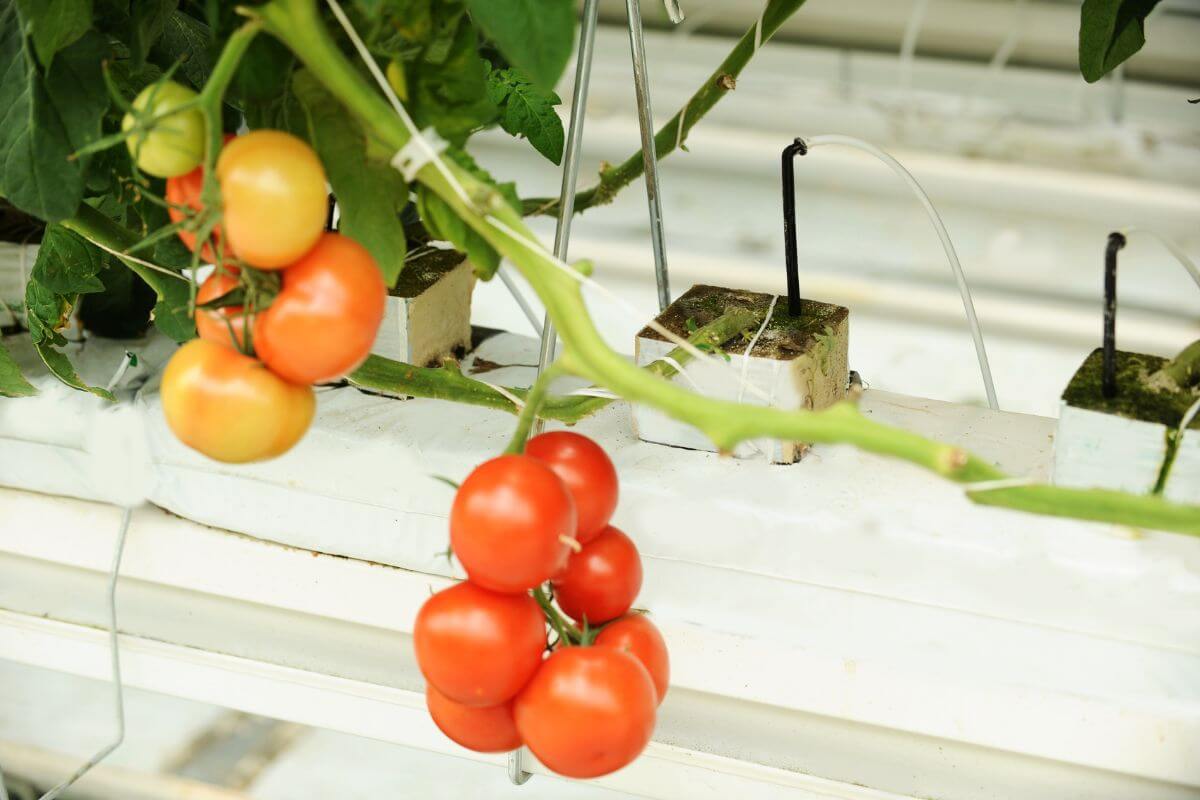
Hydroponic tomato cultivation requires a balanced mix of both macronutrients and micronutrients for optimal growth and health. The appropriate nutrient solution varies during different stages of development.
During the initial growth phase of tomato plants, they need significant quantities of nitrogen, calcium, and potassium along with other essential nutrients.
Tomato plants in bloom have a greater need for phosphorus and potassium in their nutrient solution.
Unlock your plant’s full potential by adding essential micronutrients like boron, iron, and manganese to your nutrient solution!
They can always be added through a dry, nutrient mix solution, should your hydroponic plants be lacking anything in their diet.
Prior to any nutrient mixes being added, always check the nutrient levels in your water with an EC meter as the readings will give a clear indication of what nutrients to add.
Pollination
Hydroponically grown tomatoes are self-pollinating and do not require external pollination as they have both male and female parts.
Say goodbye to the hassle of growing tomatoes with hydroponics. Let the magic happen as your tomatoes thrive effortlessly!
Pruning the Plants
Pruning and maintaining plants is a necessary aspect of hydroponic farming.
Daily pruning and removal of dead leaves are necessary for maintaining healthy tomato plants.
The tomato roots will start to take the strain, should you neglect to prune your tomato plants.
Always remove any unnecessary branches or plants that have been infected with any disease. Leaving disease-infected plants in your system will ruin your entire crop.
Tomato plants can grow high and begin to touch your grow lights so you would need to trim back the tops of the tomato plant to keep them in optimal height.
Failing to prune your tomato plants will result in a smaller-sized tomato. Your plants will waste their energy and nutrients on growing when they should be focused on producing juicy and fresh tomatoes.
Propagating the Plants
Propagating tomatoes in hydroponics can be done by germinating tomato seeds.
Germinate your tomatoes in a tray, using rock wool as a growing medium. The rock wool must be soaked in water, prior to placing the tomato seeds.
Watch in amazement as tiny seeds transform into thriving tomato plants before your very eyes!
With just a few days of germination and development, these little guys will sprout into vibrant seedlings. But don’t forget to give them 12 hours of daily light exposure for optimal growth!
Seedlings need light, but not in all the wrong places—proper lighting direction is the key to keeping their roots happy and healthy!
Transform your seedlings into thriving hydroponic plants by giving them a cozy new home in your hydroponic pots!
Following transplantation, the seedlings will initiate root development within the hydroponic system.
Harvest the Tomato
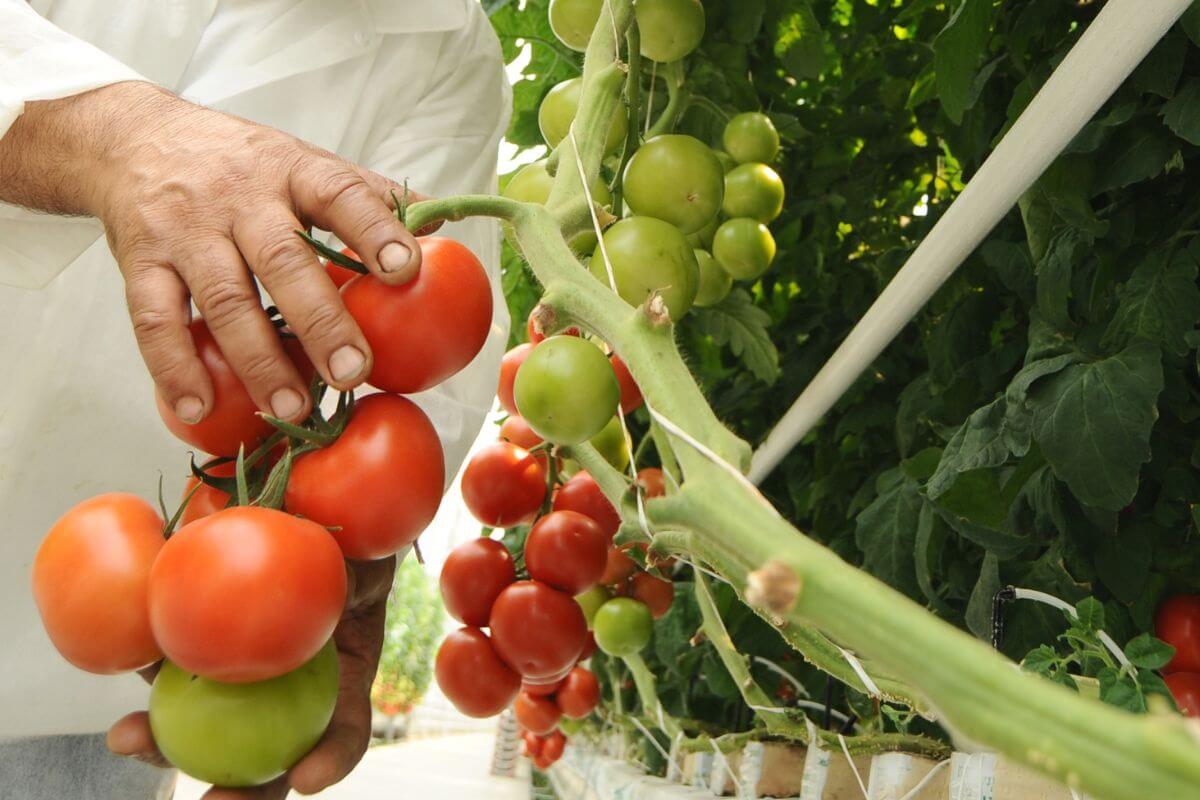
Hydroponic tomatoes will take between 4 to 12 weeks to begin flowering. You can expect to harvest your tomatoes within 50 days from seed to end product.
Harvest your tomatoes by cutting them from their stems and removing them from your plants.
Tomatoes must be harvested from their plants when they are a slightly darker red color. Don’t let your tomatoes ripen in excess, as they will begin to rot on the stem.
Troubleshooting Hydroponically Growing Tomatoes
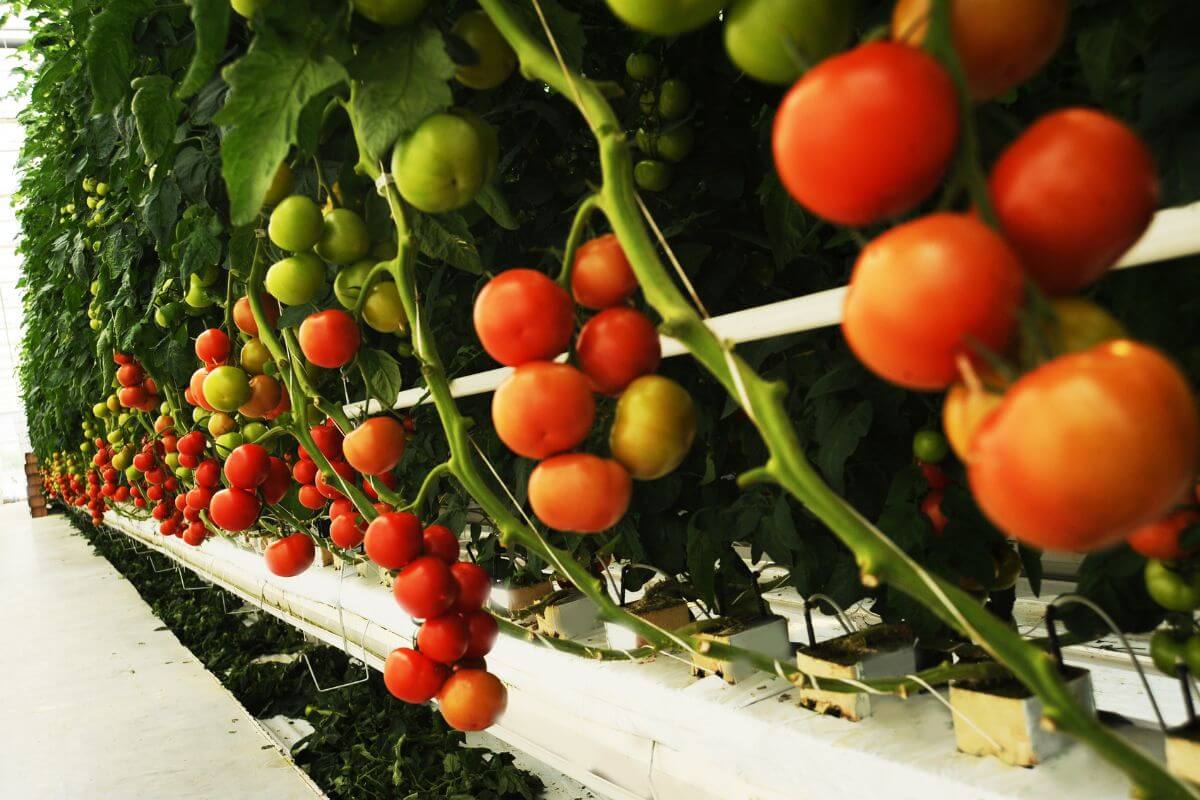
Common Growth Problems
Growing hydroponic tomatoes will present some challenges for growers, especially first-time ones. Some of these problems have quick fixes, others can be destructive and lead to potential plant loss.
The most common problems that hydroponic tomato growers experience are:
Diseases
The plant disease that will affect your plants can be caused from the start of your growth. Seeds are potential pathogens for diseases that affect tomato plants.
The humidity resulting from hydroponics provides an ideal breeding ground for fungi. Maintaining humidity levels between 40-60% is advised to prevent fungal growth on plants.
Pests
Maintaining a controlled environment and avoiding external items in the grow room are essential in preventing pest infestations in hydroponic tomato plants.
Always check all your equipment before you expose it to your grow room.
Do regular daily inspections on your plant’s leaves and around your tomatoes, and always be observant of any changes in your plants.
Nutrient issues
Nutrient issues can be solved by using an EC meter and testing the nutrients in your water. Following a nutrient chart will provide a basic guide to adding the correct types of nutrients to your system.
Should you be experiencing problems with your water, empty your water reservoir and refill it with water that has the correct pH levels.
Add the correct amounts of basic nutrient solution to your water reservoir. You will then have a clear understanding of what essential plant nutrients your plants have absorbed or still need.
The electrical conductivity (EC) of the nutrient solution varies by the different stages.
- EC for Stage 1 should be approximately 2.0 dS m-1 due to lower nutrient concentration.
- EC for Stage 3 should be closer to 2.4 dS m-1.
- If the source water contains salts, EC can be higher.
Insufficient lighting
Your tomato plant’s growth could be stunted by insufficient or inadequate light sources.
Tomato plants need at least 9 hours of direct sunlight, so make sure that you are supplying them with adequate light to grow.
Water temperature
The water temperature in your hydroponic system must be monitored as tomatoes enjoy slightly warmer water.
If your water is too cold, it will stunt your plant’s growth and delay your harvest.
Common Pests
Various pests can be found in hydroponic farms, with some affecting tomato crops more than others:
- Aphids – Aphids are small, soft-bodied insects that feed on the sap of plants and can cause damage to plants by sucking the plant’s juices. Aphids reproduce rapidly and can spread quickly throughout your hydroponic system.
- Whiteflies – Whiteflies are small winged insects that also damages tomatoes by sucking the plant’s juices. Whiteflies also secrete a sticky residue which can attract other pests, leading to further infestation.
- Thrips – A type of small, slender insect that can have a negative impact on plants by feeding on their cells and extracting their sap.
- Spider mites – Tiny arachnids that consume plant sap and have a reddish color. They damage plants by sucking the plant’s juices and leaving behind a distinctive web-like pattern on leaves.
- Fungus gnats – A type of small flying insect that feeds on decaying plant matter and fungi. Their eggs laid in the soil can cause damage to plants by feeding on the roots of hatching larvae, resulting in stunted growth or death.
Don’t let pests ruin your crops! The key to effective pest control is prevention, so keep those critters out of your growing area and watch your yields soar!
One way to ensure cleanliness in your grow area is by regularly inspecting and sanitizing your equipment and conducting pre-entry checks.
Insecticidal soap is a recommended solution for dealing with potential pest infestations as it has been proven to effectively eliminate common pests.
Bio-pesticides provide a safe and effective option for managing plant pests like aphids and spider mites, serving as an alternative to conventional pesticides.
A more natural eradication technique is to place ladybugs in and around your tomato plants. If there are any pests around, the ladybugs will eat them out.
Common Diseases
While hydroponic tomatoes are generally hardy, they can be affected by certain diseases if proper care isn’t taken. The most common diseases that affect hydroponic tomatoes are caused by pests and fungi.
The most common diseases that affect hydroponic tomatoes are:
Powdery Mildew
Yellow spots on tomato leaves are a sign of powdery mildew, which causes the leaves to turn yellow and fall off the plant.
In order to minimize the transmission of the disease, it is advised to uphold adequate ventilation and airflow within your hydroponic grow room and eliminate any diseased dead leaves.
Adding a nitrogen supplement to your nutrient solution will help your plant fight the nutrient deficiencies that the disease causes.
Blight
Blight causes yellowed leaves to occur on your tomato plants. These spots will turn brown rather quickly. The stems of your tomato plants will begin to blacken and cause the plant to die.
To prevent this disease from occurring, don’t use too much nitrogen in your nutrient solution.
The regular trimming of leaves and clearing of any dead matter in your hydroponic pots will also prevent blight from occurring.
Botrytis
The symptoms of botrytis cause the leaves of your tomato plant to have grey rot and brown spots. The symptoms may also be observed in tomatoes.
This disease can be prevented by planting varieties of tomatoes that are immune to this disease.
Additionally, regular cleaning and removal of plant waste in your hydroponic system will decrease the chances of this disease affecting your plants.
Fusarium wilt
Fusarium wilt destroys the foliage in your plant leaves and turns them black. The disease is a soil-based disease that enters plants through their root system.
In hydroponic system, this disease is caused by planting infected seeds, or through pests infecting your plants.
Maintaining the cleanliness of equipment during the setup of a hydroponic tomato system is crucial for disease prevention.
Monitoring plants for signs of disease is crucial and prompt action should be taken if any are detected.
Final Thoughts on Growing Hydroponic Tomatoes
Growing hydroponic tomatoes can be a valuable and amazing experience, but it takes time, attention, and proper equipment.
It is an excellent way to grow plants without soil and take advantage of various technological advancements and allows gardeners to grow tomatoes without relying on external factors.
Proper care can result in a faster growth rate and larger, juicier tomatoes with excellent taste and nutritional value in a hydroponic tomato garden.
With a little effort and care, a hydroponic system can yield a bounty of benefits that’ll make all your hard work worth it in the end!
Transform your gardening game with the hassle-free and enjoyable experience of growing juicy tomatoes through hydroponics!
With the right knowledge, tools, and techniques, gardeners of all levels can bask in the sweet satisfaction of harvesting their own fresh tomatoes!
For further information on hydroponic plants, check out these recommended readings:

